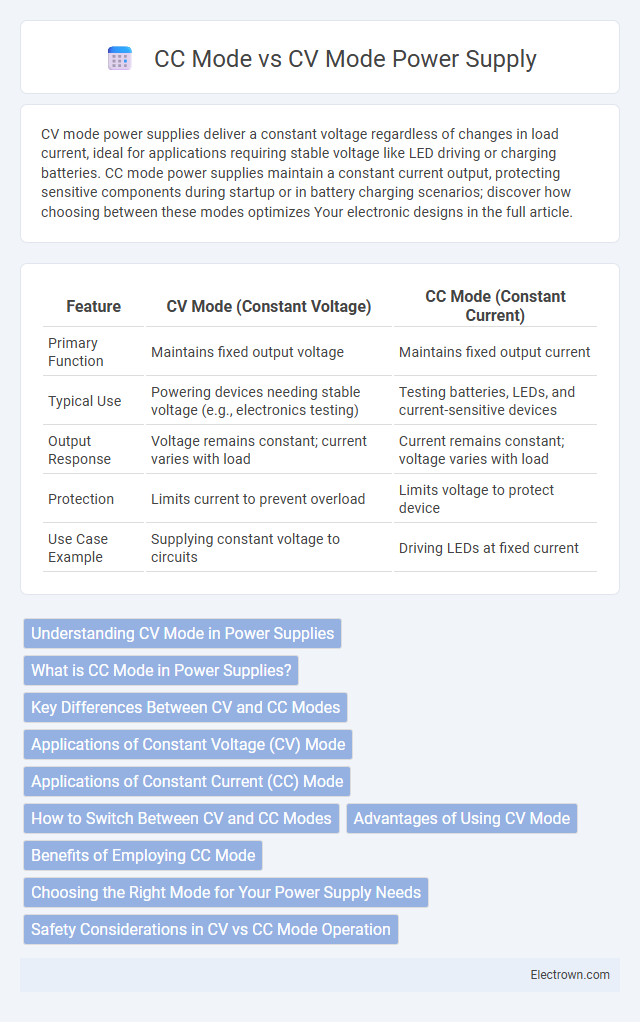CV mode power supplies deliver a constant voltage regardless of changes in load current, ideal for applications requiring stable voltage like LED driving or charging batteries. CC mode power supplies maintain a constant current output, protecting sensitive components during startup or in battery charging scenarios; discover how choosing between these modes optimizes Your electronic designs in the full article.
Table of Comparison
| Feature | CV Mode (Constant Voltage) | CC Mode (Constant Current) |
|---|---|---|
| Primary Function | Maintains fixed output voltage | Maintains fixed output current |
| Typical Use | Powering devices needing stable voltage (e.g., electronics testing) | Testing batteries, LEDs, and current-sensitive devices |
| Output Response | Voltage remains constant; current varies with load | Current remains constant; voltage varies with load |
| Protection | Limits current to prevent overload | Limits voltage to protect device |
| Use Case Example | Supplying constant voltage to circuits | Driving LEDs at fixed current |
Understanding CV Mode in Power Supplies
CV mode in power supplies ensures a constant voltage output, maintaining a steady voltage level regardless of changes in load current, which is essential for sensitive electronics requiring stable voltage. This mode adjusts the current dynamically to prevent voltage fluctuations, protecting your components from damage due to over-voltage conditions. Understanding CV mode allows you to select the right power supply configuration for applications demanding precise voltage regulation.
What is CC Mode in Power Supplies?
CC mode in power supplies stands for Constant Current mode, where the device regulates and maintains a fixed current output regardless of voltage changes. This mode is essential for applications like LED driving or battery charging, where current control is critical to prevent damage. Your choice of CC mode ensures stable current flow, protecting sensitive components and optimizing performance.
Key Differences Between CV and CC Modes
CV (Constant Voltage) mode maintains a fixed output voltage regardless of load variations, ideal for powering devices requiring stable voltage like LEDs or electronic circuits. CC (Constant Current) mode delivers a steady current output, suitable for applications such as battery charging where current regulation is critical. The key difference lies in regulation focus: CV mode regulates voltage to prevent fluctuations, while CC mode controls current to protect sensitive components from overcurrent conditions.
Applications of Constant Voltage (CV) Mode
Constant Voltage (CV) mode power supplies provide a fixed output voltage regardless of changes in load current, making them ideal for applications such as LED drivers, battery charging, and electroplating processes. Your electronic devices benefit from stable voltage delivery in CV mode, ensuring consistent performance and preventing damage from voltage fluctuations. This mode is especially crucial in scenarios where precise voltage control is necessary for sensitive components or processes.
Applications of Constant Current (CC) Mode
Constant Current (CC) mode power supplies are essential for applications requiring precise control of current to protect components, such as LED driving, battery charging, and electroplating processes. You benefit from CC mode when managing devices that must maintain a steady current despite fluctuations in load resistance or voltage. This mode ensures device safety and reliability, especially in semiconductor testing and laser diode operation.
How to Switch Between CV and CC Modes
Switching between CV (Constant Voltage) and CC (Constant Current) modes on a power supply usually involves adjusting the output settings or enabling specific control buttons depending on the model. Most modern programmable power supplies feature an intuitive interface with toggle buttons or menu-driven commands to select CV or CC modes, allowing users to set the desired voltage or current limits precisely. Properly configuring the mode ensures optimal device protection by maintaining either a steady voltage or a steady current, critical for testing and powering electronic circuits safely.
Advantages of Using CV Mode
CV mode power supplies provide stable voltage output, essential for applications requiring precise voltage control such as LED driving or battery charging. Your devices benefit from protection against voltage fluctuations, ensuring consistent performance and reducing the risk of damage. Enhanced efficiency and better thermal management in CV mode contribute to prolonged equipment lifespan and reliable operation.
Benefits of Employing CC Mode
CC mode power supplies provide precise current regulation, essential for protecting sensitive components from overcurrent damage. Your devices benefit from stabilized current delivery that enhances safety and performance during testing and operation. This mode is particularly valuable in applications like LED driving and battery charging, where maintaining a constant current ensures optimal functionality and longevity.
Choosing the Right Mode for Your Power Supply Needs
Selecting the appropriate mode for your power supply depends on your application requirements: Constant Voltage (CV) mode maintains a steady output voltage, ideal for devices sensitive to voltage changes, while Constant Current (CC) mode delivers a fixed current, critical for applications like battery charging or LED driving. Choosing CV mode ensures protection against voltage spikes and maintains device stability, whereas CC mode prevents overcurrent damage and controls the current flow precisely. Understanding the load characteristics and performance criteria helps optimize power supply efficiency and device safety.
Safety Considerations in CV vs CC Mode Operation
In CV (Constant Voltage) mode, power supplies maintain a steady voltage while allowing current to vary, reducing the risk of overcurrent damage, making it safer for voltage-sensitive devices. CC (Constant Current) mode, by contrast, limits current to protect against overcurrent scenarios, essential when powering current-sensitive loads or preventing device burnout. Understanding these safety considerations ensures your application operates within safe electrical parameters, minimizing risks of failure or hazards.
cv mode vs cc mode power supply Infographic

 electrown.com
electrown.com